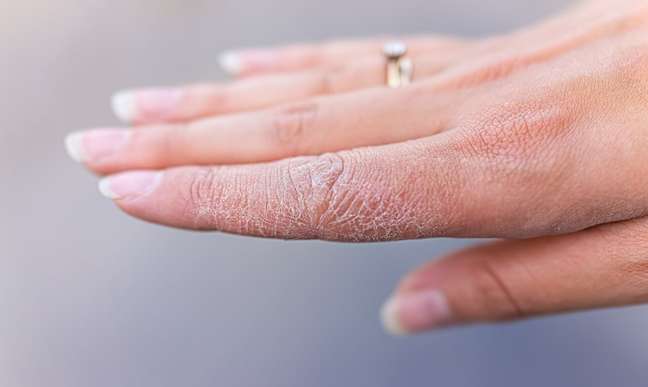The disease causes blisters on the hands and feet, which can cause itching and pain. Understand what dyshidrosis is

Dyshidrosis is a disease that causes small blisters and clear blisters to appear with a red area on the palms and soles of the feet. According to the Brazilian Society of Dermatology, these lesions can cause itching and pain. Subsequently, the blisters turn into peeling skin.
In 70-80% of patients, the disease affects only the hands. In milder cases, the blisters may appear only on the lateral surface of the fingers, occupying a very limited region. Additionally, the vesicles can clump together to form larger blisters. Dyshidrosis almost always resolves within one to three weeks, but it can become chronic.
“These symptoms mostly appear on the hands and feet, where we sweat the most. They are vesicles with fluid that can blister when they are close. The symptoms of dyshidrosis last from one to three weeks and can take weeks to several months to appear again. “says Clessya Rocha, a dermatologist at the Brazilian Society of Dermatology (SBD).
Causes and treatment of dyshidrosis
According to Clessya, dyshidrosis can be caused by contact dermatitis, fungal infections, or pharmacoderma. The condition is more common in the warm months and is often associated with hyperhidrosis. Emotional factors can make it worse or even trigger it, according to SBD.
Clinical diagnosis is made only by a specialist. The dermatologist points out that no health advice or content on the Internet replaces a visit to the doctor.
“Look for a dermatologist to examine the lesions and ask for an allergy test to clarify whether it is an allergic contact dermatitis or a skin manifestation of a fungal infection. Only then begins the appropriate treatment”, reinforces the specialist, who is also a Professor of Dermatology at the State University of Southwest Bahia (UESB).
Also according to the SBD, in the acute phase the treatment consists of compresses or baths with potassium permanganate or 2% boric water, two to three times a day, until the lesions improve. A high-potency corticosteroid cream, or a water paste, can be used in conjunction with compresses or after the condition has improved.
In severe cases, the use of oral corticosteroids is a form of treatment. In cases that do not respond to conventional therapy, topical immunosuppressants and / or PUVAs may be used. In the chronic stage, corticosteroid creams and ointments, tacrolimus, pimecrolimus and coal tar are used. Superficial Grenz radiation therapy (soft x-rays) should be considered at this stage.
+The best content in your email for free. Choose your favorite Earth Newsletter. Click here!
Source: Terra
Benjamin Smith is a fashion journalist and author at Gossipify, known for his coverage of the latest fashion trends and industry insights. He writes about clothing, shoes, accessories, and runway shows, providing in-depth analysis and unique perspectives. He’s respected for his ability to spot emerging designers and trends, and for providing practical fashion advice to readers.




![Plus Belle La Vie ADHER: Mistral farewell to Samuel … which awaits you a week from June 14 to July 18, from July 18, 2025 to July 18, 2025 [SPOILERS] Plus Belle La Vie ADHER: Mistral farewell to Samuel … which awaits you a week from June 14 to July 18, from July 18, 2025 to July 18, 2025 [SPOILERS]](https://fr.web.img6.acsta.net/img/7b/07/7b078e62648522533356d00e1432dca3.jpg)



